[Original Question]
I need an equation for curve that increases indefinitely as time elapsed increases based on data below. How to get that?
[Updates on the question]
I need to specify proper parameters for scipy.interpolate.splrep. Can someone helpout?
Also, Is there a way to get an equation from coeffs of b spline?
[Alternate question]
How to get a fit using decomposition of signal in Fourier series?
This plot seems to be a combination of linear plot, a periodic function pf1 which increases four time, a larger periodic function which causes pf1 to happen again and again indefinitely. The difficulty of the plot is the reason which is why this question has been asked.

Data:
Time elapsed in sec. TX + RX Packets
(0,0)
(10,2422)
(20,2902)
(30,2945)
(40,3059)
(50,3097)
(60,4332)
(70,4622)
(80,4708)
(90,4808)
(100,4841)
(110,6081)
(120,6333)
(130,6461)
(140,6561)
(150,6585)
(160,7673)
(170,8091)
(180,8210)
(190,8291)
(200,8338)
(210,8357)
(220,8357)
(230,8414)
(240,8414)
(250,8414)
(260,8414)
(270,8414)
(280,8414)
(290,8471)
(300,8471)
(310,8471)
(320,8471)
(330,8471)
(340,8471)
(350,8471)
(360,8471)
(370,8471)
(380,8471)
(390,8471)
(400,8471)
(410,8471)
(420,8528)
(430,8528)
(440,8528)
(450,8528)
(460,8528)
(470,8528)
(480,8528)
(490,8528)
(500,8528)
(510,9858)
(520,10029)
(530,10129)
(540,10224)
(550,10267)
(560,11440)
(570,11773)
(580,11868)
(590,11968)
(600,12039)
(610,13141)
My Code:
import numpy as np
import matplotlib.pyplot as plt
points = np.array(
[(0,0), (10,2422), (20,2902), (30,2945), (40,3059), (50,3097), (60,4332), (70,4622), (80,4708), (90,4808), (100,4841), (110,6081), (120,6333), (130,6461), (140,6561), (150,6585), (160,7673), (170,8091), (180,8210), (190,8291), (200,8338), (210,8357), (220,8357), (230,8414), (240,8414), (250,8414), (260,8414), (270,8414), (280,8414), (290,8471), (300,8471), (310,8471), (320,8471), (330,8471), (340,8471), (350,8471), (360,8471), (370,8471), (380,8471), (390,8471), (400,8471), (410,8471), (420,8528), (430,8528), (440,8528), (450,8528), (460,8528), (470,8528), (480,8528), (490,8528), (500,8528), (510,9858), (520,10029), (530,10129), (540,10224), (550,10267), (560,11440), (570,11773), (580,11868), (590,11968), (600,12039), (610,13141)]
)
# get x and y vectors
x = points[:,0]
y = points[:,1]
# calculate polynomial
z = np.polyfit(x, y, 3)
print z
f = np.poly1d(z)
# calculate new x's and y's
x_new = np.linspace(x[0], x[-1], 50)
y_new = f(x_new)
plt.plot(x,y,'o', x_new, y_new)
plt.xlim([x[0]-1, x[-1] + 1 ])
plt.show()
My Output:

My Code 2:
import numpy as N
from scipy.interpolate import splprep, splev
x = N.array([0, 10, 20, 30, 40, 50, 60, 70, 80, 90, 100, 110, 120, 130, 140, 150, 160, 170, 180, 190, 200, 210, 220, 230, 240, 250, 260, 270, 280, 290, 300, 310, 320, 330, 340, 350, 360, 370, 380, 390, 400, 410, 420, 430, 440, 450, 460, 470, 480, 490, 500, 510, 520, 530, 540, 550, 560, 570, 580, 590, 600, 610])
y = N.array([0, 2422, 2902, 2945, 3059, 3097, 4332, 4622, 4708, 4808, 4841, 6081, 6333, 6461, 6561, 6585, 7673, 8091, 8210, 8291, 8338, 8357, 8357, 8414, 8414, 8414, 8414, 8414, 8414, 8471, 8471, 8471, 8471, 8471, 8471, 8471, 8471, 8471, 8471, 8471, 8471, 8471, 8528, 8528, 8528, 8528, 8528, 8528, 8528, 8528, 8528, 9858, 10029, 10129, 10224, 10267, 11440, 11773, 11868, 11968, 12039, 13141])
# spline parameters
s=1.0 # smoothness parameter
k=3 # spline order
nest=-1 # estimate of number of knots needed (-1 = maximal)
# find the knot points
tckp,u = splprep([x,y],s=s,k=k,nest=nest,quiet=True,per=1)
# evaluate spline, including interpolated points
xnew,ynew = splev(N.linspace(0,1,400),tckp)
import pylab as P
data,=P.plot(x,y,'bo-',label='data')
fit,=P.plot(xnew,ynew,'r-',label='fit')
P.legend()
P.xlabel('x')
P.ylabel('y')
P.show()
My Output 2:


